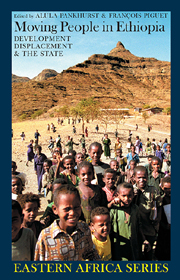Book contents
- Frontmatter
- Contents
- Acknowledgements
- Acronyms
- Glossary
- Notes on Contributors
- Preface: An Original Contribution to Country-wide Displacement Analysis
- Foreword by Alula Pankhurst & François Piguet
- Map
- Part I INTRODUCTION
- Part II THEORETICAL & INTERNATIONAL PERSPECTIVES
- Part III DEVELOPMENT-INDUCED DISPLACEMENT
- 4 Social Dimensions of Development-Induced Resettlement
- 5 The Effects of Development Projects on the Karrayu & Afar in the mid-Awash Valley
- 6 The Effects of Investment on the Livelihoods of the Tsamako in the Wayto Valley
- 7 Planning Resettlement in Ethiopia
- 8 Urban Development & Displacement of Rural Communities around Addis Ababa
- Part IV THE EXPERIENCE OF STATE-ORGANIZED RESETTLEMENT
- Part V THE DILEMMAS OF REFUGEES, RETURNEES & DISPLACED GROUPS
- Part VI CONCLUSION
- Bibliography
- Index
- EASTERN AFRICAN STUDIES
5 - The Effects of Development Projects on the Karrayu & Afar in the mid-Awash Valley
from Part III - DEVELOPMENT-INDUCED DISPLACEMENT
Published online by Cambridge University Press: 05 April 2013
- Frontmatter
- Contents
- Acknowledgements
- Acronyms
- Glossary
- Notes on Contributors
- Preface: An Original Contribution to Country-wide Displacement Analysis
- Foreword by Alula Pankhurst & François Piguet
- Map
- Part I INTRODUCTION
- Part II THEORETICAL & INTERNATIONAL PERSPECTIVES
- Part III DEVELOPMENT-INDUCED DISPLACEMENT
- 4 Social Dimensions of Development-Induced Resettlement
- 5 The Effects of Development Projects on the Karrayu & Afar in the mid-Awash Valley
- 6 The Effects of Investment on the Livelihoods of the Tsamako in the Wayto Valley
- 7 Planning Resettlement in Ethiopia
- 8 Urban Development & Displacement of Rural Communities around Addis Ababa
- Part IV THE EXPERIENCE OF STATE-ORGANIZED RESETTLEMENT
- Part V THE DILEMMAS OF REFUGEES, RETURNEES & DISPLACED GROUPS
- Part VI CONCLUSION
- Bibliography
- Index
- EASTERN AFRICAN STUDIES
Summary
Background: general conditions of pastoralists
In Ethiopia nomadic pastoralists constitute about 5 million people (Fecadu 1990) living in the dry lowlands and relatively arid climatic zones. Mainly transhumant, they belong to some 29 linguistic groups classified as Cushitic, Nilotic and Omotic. The area they occupy covers slightly less than 50 percent (500,000 km2) of the country and encircles the central highlands and border areas of neighbouring countries (UNDP/RRC 1984).
Mainstream thinking holds that parts of Ethiopia inhabited by population groups whose economic mainstay is livestock husbandry are geographically, environmentally and economically marginal. However, these areas occupied by pastoralists are believed to be endowed with unexploited natural resources. Oil and gas are said to be in relative abundance in most lowland areas, notably the Ogaden (Yacob 1995). The lowlands are further characterized by plains watered by perennial rivers; the Blue Nile, Tekeze, Omo and Wabeshebelle Rivers and the Baro Akobo and Ganale- Juba-Dawa systems meander through the pastoral lands of Ethiopia before they cross the country's frontiers in almost all directions (ibid). Thus, the pastoral areas, by and large, lend themselves to large-scale agricultural development and are therefore attractive to outsiders.
- Type
- Chapter
- Information
- Moving People in EthiopiaDevelopment, Displacement and the State, pp. 66 - 80Publisher: Boydell & BrewerPrint publication year: 2009



